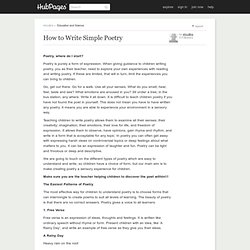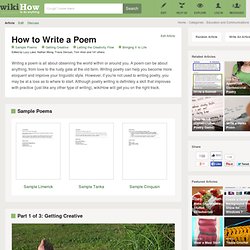

How to Write Simple Poetry. Poetry, where do I start?

Poetry is purely a form of expression. When giving guidance to children writing poetry, you as their teacher, need to explore your own experiences with reading and writing poetry. If these are limited, that will in turn, limit the experiences you can bring to children. Go, get out there. Go for a walk. Teaching children to write poetry allows them to examine all their senses; their creativity; imagination; their emotions, their love for life, and freedom of expression. We are going to touch on the different types of poetry which are easy to understand and write, so children have a choice of form, but our main aim is to make creating poetry a sensory experience for children. Make sure you are the teacher helping children to discover the poet within!!!
The Easiest Patterns of Poetry The most effective way for children to understand poetry is to choose forms that can intermingle to create poems to suit all levels of learning. 1. A Rainy Day Heavy rain on the roof 2. 3. Write an Instant "I Can't Write a Poem" Poem. Write a Gem of a Poem. How to Write Poetry - Creative Writing Lessons. Do you want to learn how to write poetry or how to improve as a poet?

Would you like step-by-step advice on how to get poetry ideas and turn them into poems? You're in the right place! Find answers to these questions: "What should I write poems about? " "How should I decide the right form for my poem? " Advertisement: Anybody Can Write a Poem. How to Write a Poem (with 3 Sample Poems) Edit Article Sample PoemsGetting CreativeLetting the Creativity FlowBringing It to Life Edited by Lucy Lake, Nathan Wong, Travis Derouin, Tom Viren and 141 others Writing a poem is all about observing the world within or around you.

A poem can be about anything, from love to the rusty gate at the old farm. Writing poetry can help you become more eloquent and improve your linguistic style. Ad Steps Part 1 of 3: Getting Creative 1Find a spark. 4Decide which poetry style suits your subject. Part 2 of 3: Letting the Creativity Flow 1Choose the right words. 4Add a "turn" to the end of the poem.
Part 3 of 3: Bringing It to Life 1Listen to your poem. 3Share your work. Tips Don't frustrate yourself by too persistently sharing your work with people who do not appreciate poetry. Article Info Featured Article Categories: Featured Articles | Poetry | Writing Recent edits by: Jakesoup, Lugia2453, LeahlovesGod In other languages: